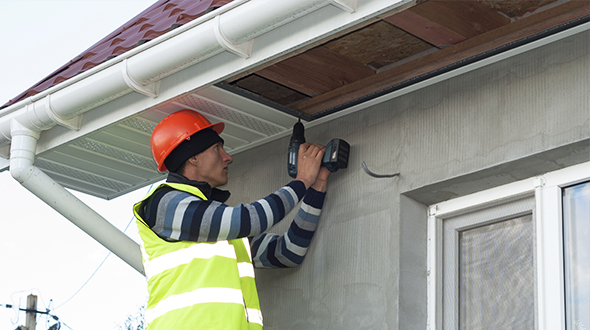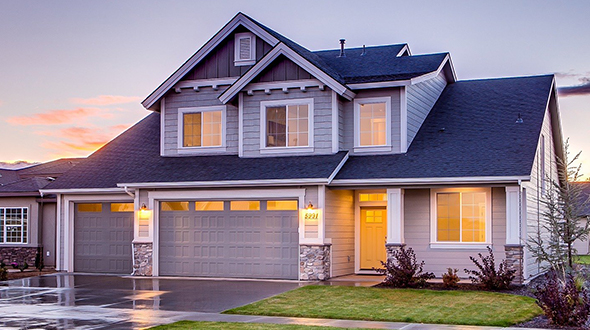
A soffit is a critical component to prevent decay and eventual roof failure due to excess moisture accumulating in your attic. Discover what else your soffit does to help your roofing system meet its intended life expectancy.
atlantacommercialroofingcontractors.com gathered the following information about what a soffit is, its purpose, and why it is essential to your roofing system’s success.
What Is a Soffit?
When a sloped roof descends from the peak to the exterior walls of a structure, the roof will overhang the structure by 1 to 2 feet. Where you have tiles, shingles, or metal roofing on the topside, the soffit is the component underneath the overhang that protects the rafters, attic space, and roof substrate or decking from excess moisture, severe weather infiltration, potential mold growth and helps your roofing system last for the duration of its intended lifespan.

What Is The Difference Between Soffits and Fascia?
Soffits and fascia are installed together, forming a barrier between external elements and the attic space created by your sloping roofing system. Looking at a structure at street level, you may say the trim around the foot of the roof looks well-done. This “trim” is the fascia. With the soffit underneath the overhang and the fascia closing the gap between the soffit and the roof, the barrier, as mentioned earlier, is formed. These roofing components:
- Deter bee, hornet, and other insect infestations
- Stop wildlife (squirrels, raccoons, cats, etc.) from nesting in your attic
- Prevent water (wind-driven rain) from getting in your attic
- Keep your attic ventilated, preventing a buildup of moist/humid air that could lead to mold, mildew, and rotting problems
- Prevent premature aging of your roofing system
Soffits and fascia, when well-installed, can add to the visual “completeness” of the structure. Thus, adding curb appeal and potentially increasing the property’s overall value.
Note: Gutter systems installed around the foot of a sloped roofing system are typically affixed to the fascia. This is done in a manner that guides water runoff away from the roofing system, doorways, windows, and other vulnerable areas.

Soffit and Fascia Materials
To complement the construction of your home or type of roofing system, you can find soffit panels and fascia boards made from many different materials and finished in a wide variety of colors and textures.
Soffits and fascia are typically made from materials like:
Aluminum – Lasts 20+ years with colors and texture baked in to prevent fading.
Wood – Depending on the wood and maintenance, lasts 5 to 15 years.
UPVC (Unplasticised Polyvinyl Chloride) – Lasts 10 to 20 years and comes in multiple colors and textures but may fade or become brittle over time.
Vinyl – Similar to uPVC, lasts 10 to 20 years, is available in multiple colors and textures, and can become faded and/or brittle over time.
Steel – Lasts 25+ years with multiple colors and textures that resist fading.
Fibre Cement Board – Lasts 30+ years when properly installed and will never peel, chip, or rot.
Note: As with all roofing materials, the durability of the above-mentioned fluctuates with the quality, thoroughness, and frequency of your maintenance program.
Watch this video to see soffit and fascia trim installation.
Soffit and Fascia Installation and Repair Costs
Generally speaking, you will rarely need to replace all of your soffits and/or fascia. This will usually occur only when your roofing system is replaced.
In cases of roof replacement, soffit and fascia installation (labor and materials) will likely be included in your overall estimate or bid. You can ask for these as detailed line items in your estimate.
Soffit and/or fascia installation or repair will run in the $5 to $25 per linear foot range.
Note: Supply and demand will significantly impact the prices of materials considered commodities (wood materials).
Why Your Home Needs Soffits
In this article, you discovered what soffits are, what they do, and how they contribute to the success and longevity of your roofing system.
Keeping your soffits well-maintained allows them to properly ventilate your home’s attic while keeping moisture, severe weather, and destructive animal or insect infestations from taking years off the life of your roofing system.
Allowing your soffits to deteriorate or go without proper maintenance will lead to severe weather events, animals, insects, and humidity causing sere and costly damage to your roofing system and building structure.
Sources:
energy.ces.ncsu.edu/soffit-defined/
ucanr.edu/sites/Wildfire/Vents/
uvm.edu/~cferreir/131Eave%20Details.pdf